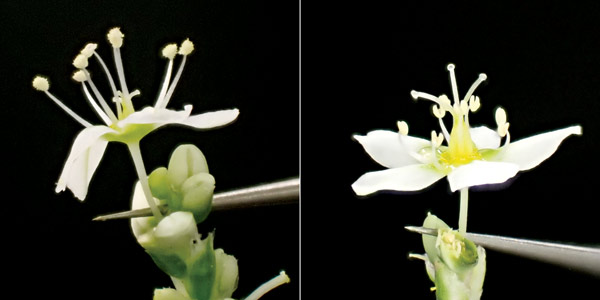Dec. 7, 2023 Research Highlight Biology
High-quality genome for common buckwheat will help improve crops
A high-quality genetic analysis of common buckwheat provides insights into its domestication history and will help develop more useful crops

Figure 1: Close-up photographs of the long-styled (left) and short-styled (right) flower morphs of the buckwheat plant. Buckwheat has an unusual fertilization system that involves two morphs. From Ref. 1. Reproduced with permission from SNCSC.Science
A team that included RIKEN scientists has sequenced the genome of common buckwheat—a crop that has desirable traits such as growing well in poor soils and at high altitudes. This analysis provides insights into its domestication history and will help guide the development of improved strains1.
Common buckwheat is an ‘orphan crop’—one that is popular in specific regions around the world but is not yet traded internationally. It is mainly produced in the Russian Federation, China and a handful of other countries.
Buckwheat has an unusual fertilization system. Each individual plant has one of two different flower shapes, or morphs—one flower morph has a long style and short stamen, while the other has a short style and long stamen. All the flowers on a plant have the same morph, which prevents self-fertilization since fertilization can only occur between individuals with opposite morphs. While this aspect is identical to two sexes, both morphs retain functional male (stamen) and female (style) organs.
A team led by Jeffrey Fawcett of the RIKEN Interdisciplinary Theoretical and Mathematical Sciences Program has now investigated the genetic drivers behind this intriguing trait and were surprised by the results.
“It was thought that several genes controlling different aspects of the floral morphology and compatibility would have to work together, and researchers were puzzled as to how such a system requiring several genes to be coupled could emerge,” explains Fawcett. “But we found that a single gene regulated the length and compatibility of the style.”
The genome will be a valuable resource. “A high-quality reference genome provides the cornerstone for basic and applied research for any species,” says Fawcett. “Genome insights help us realize the potential of crop plants, ultimately enhancing food security and helping to feed the world’s growing population.”
The team also developed a high-throughput genomics method to alter traits in buckwheat. Using this technique, they generated a novel strain that has a stickier, waxier texture than traditional buckwheat—making it more versatile for food preparation. “Japan loves buckwheat noodles (soba), but producers have to add wheat flour to make them stick together,” says Fawcett. “Now this strain could do that job naturally.”
Using the genome, the researchers also verified that the domesticated crop originated in southeast Tibet.
“It’s a rare example of a crop that originated in this part of the world and dispersed across Eurasia,” says Fawcett. “What traits did those people value in the crop and why? How does the cultivated crop differ from wild-type buckwheat? We intend to examine these questions, while continuing to develop new strains of buckwheat.”
Related contents
- Searching for buckwheat’s origin
- Green millet genome resource provides a valuable tool for studying major crops
- The genome and transcriptome of the parasitic plant Striga have been sequenced
Rate this article
Reference
- 1. Fawcett, J .A., Takeshima, R., Kikuchi, S., Yazaki, E., Katsube-Tanaka, T., Dong, Y., Li, M., Hunt, H. V., Jones, M. K., Lister, D. L. et al. Genome sequencing reveals the genetic architecture of heterostyly and domestication history of common buckwheat. Nature Plants 9, 1236–1251 (2023). doi: 10.1038/s41477-023-01474-1
